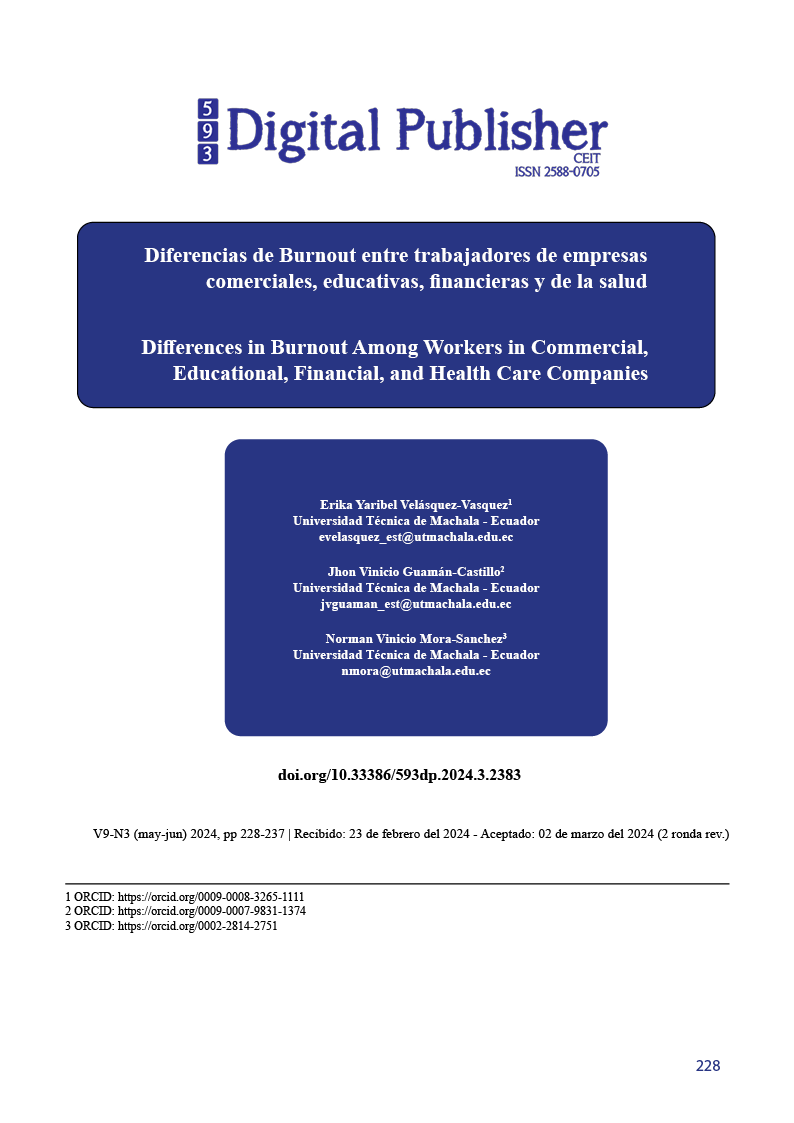Differences in Burnout Among Workers in Commercial, Educational, Financial, and Health Care Companies
Main Article Content
Abstract
Burnout is one of the most prevalent work-related psychopathologies today and has been associated with different factors, including age and gender. Companies in the province of El Oro do not usually conduct diagnoses on burnout; therefore, human talent management and productivity are at risk. Hence, the objective of this research was to diagnose levels of burnout and identify differences by age, gender, and sector. The methodology used is descriptive, cross-sectional, and quantitative. The survey technique was used for primary information gathering, and a literature review was conducted to construct the theoretical framework. A sample of 384 workers from the commercial, educational, financial, and health sectors was taken. The MBI-General Survey instrument was applied to them, and high reliability levels were obtained in the three dimensions: Exhaustion (α=0.952), Cynicism (α=0.960), and Professional Efficacy (α=0.974). Through MANOVA analysis, it was observed that the differences in burnout regarding perceived professional efficacy among workers from the four sectors are significant, with those from the commercial, educational, and health sectors being the most vulnerable. Regarding age and gender, the former variable is not related to burnout, but the latter is when it interacts together with the sector where a person works.
Downloads
Article Details

This work is licensed under a Creative Commons Attribution-NonCommercial-ShareAlike 4.0 International License.
1. Derechos de autor
Las obras que se publican en 593 Digital Publisher CEIT están sujetas a los siguientes términos:
1.1. 593 Digital Publisher CEIT, conserva los derechos patrimoniales (copyright) de las obras publicadas, favorece y permite la reutilización de las mismas bajo la licencia Licencia Creative Commons 4.0 de Reconocimiento-NoComercial-CompartirIgual 4.0, por lo cual se pueden copiar, usar, difundir, transmitir y exponer públicamente, siempre que:
1.1.a. Se cite la autoría y fuente original de su publicación (revista, editorial, URL).
1.1.b. No se usen para fines comerciales u onerosos.
1.1.c. Se mencione la existencia y especificaciones de esta licencia de uso.
References
Bang, H., & Reio, T. (2017). Examining the role of cynicism in the relationships between burnout and employee behavior. Journal of Work and Organizational Psychology, 33(3), 217-227. https://doi.org/10.1016/j.rpto.2017.07.002
Bresó, E., Salanova, M., & Schaufeli, W. (2007). NTP 732: Síndrome de estar quemado por el trabajo "Burnout" (III): Instrumento de medición. https://www.insst.es/documents/94886/326775/ntp_732.pdf
Cantoni, N. (2009). Técnicas de muestreo y determinación del tamaño de la muestra en investigación cuantitativa. Revista Argentina de Humanidades y Ciencias Sociales, 7(2), en línea. https://www.sai.com.ar/metodologia/rahycs/rahycs_v7_n2_06.htm
Cardoso de Moura, E., Furtado, L., & Sobral, F. (2020). The burnout epidemic during the COVID-19 pandemic: The role of LMX in alleviating physicians' burnout. RAE - Revista de Administracao de Empresas, 60(6), 426-436. https://doi.org/10.1590/S0034-759020200606
Clasificación Internacional de Enfermedades. (1 de enero de 2023). QD85 Burnout. ICD-11 for Mortality and Morbidity Statistics: https://icd.who.int/browse11/l-m/en
Clasificación Internacional de Enfermedades. (1 de enero de 2023). QD85 Síndrome de desgaste ocupacional. ICD-11 for Mortality and Morbidity Statistics: https://icd.who.int/browse11/l-m/es
Figueiredo, B., Pizarro, C., & Koller, S. (2014). Occupational Self-Efficacy Scale - Short Form (OSS-SF): Adaptation and evidence of construct validity of the Brazilian version. Revista Brasileira de Orientação Profissional, 15(1), 65-74. http://pepsic.bvsalud.org/pdf/rbop/v15n1/08.pdf
González, J., Moreno, R., Peñacoba, C., Alcocer, N., Alonso, L., del Barco, P., & Ardoy, J. (2003). Burnout en terapia ocupacional: un análisis focalizado sobre el nivel de consecuencias individuales y organizacionales. Revista de Psicología del Trabajo y de las Organizaciones, 19(1), 59-73. https://journals.copmadrid.org/jwop/files/82815.pdf
Igartua, M. (2023). El enfoque de género y la enfermedad profesional: reflexiones desde el ordenamiento español. Revista Internacional y Comparada de RELACIONES LABORALES Y DERECHO DEL EMPLEO, 11(2), 6-41. https://ejcls.adapt.it/index.php/rlde_adapt/article/view/1268
Instituto Nacional de Estadística y Censos. (28 de febrero de 2023). Encuesta Nacional de Empleo, Desempleo y Subempleo. https://www.ecuadorencifras.gob.ec/documentos/web-inec/EMPLEO/2022/Anual/Bolet%C3%ADn%20t%C3%A9cnico%20anual%20enero-diciembre%202022.pdf
Instituto Nacional de Estadística y Censos. (s.f.). Censo Ecuador. https://www.censoecuador.gob.ec/data-y-resultados/
Johnson, S., Machowski, S., Holdsworth, L., Kern, M., & Zapf, D. (2017). Age, emotion regulation strategies, burnout, and engagement in the service sector: Advantages of older workers. Journal of Work and Organizational Psychology, 33(3), 205-216. https://doi.org/10.1016/j.rpto.2017.09.001
La Falce, J., Santos, C., De Muylder, C., & Guimarae, L. (2023). The influence of burnout on the organizational commitment of healthcare professionals. RAE - Revista de Administracao de Empresas, 63(3), 1-19. https://doi.org/10.1590/S0034-759020230305
López, P. (2004). Población, muestra y muestreo. Punto Cero, 9(8), 69-74. http://www.scielo.org.bo/pdf/rpc/v09n08/v09n08a12.pdf
Montes, G. (2023). Empleo digital, conciliación y salud psicosocial de la mujer trabajadora. Revista Internacional y Comparada de RELACIONES LABORALES Y DERECHO DEL EMPLEO, 11(2), 186-213. https://ejcls.adapt.it/index.php/rlde_adapt/article/view/1267/1417
Morales-Llamas, Z., Pérez-Hernández, S., & Rodríguez-Suárez, G. (2020). Estudio exploratorio sobre el síndrome de burnout en la profesión de trabajo social y su relación con variables del contexto laboral. Trabajo Social Global-Global Social Work, 10(19), 304-321. https://doi.org/10.30827/tsg-gsw.v10i19.11375
Moreno-Jiménez, M., Ríos-Rodríguez, M., Canto-Ortiz, J., San Martín-García, J., & Perles-Nova, F. (2010). Satisfacción Laboral y Burnout en Trabajos Poco Cualificados: Diferencias entre Sexos en Población Inmigrante. Revista de Psicología del Trabajo y de las Organizaciones, 26(3), 255-265. https://doi.org/10.5093/tr2010v26n3a8
Osorio, M., Madero, S., & del Castillo, E. (2023). Non-frontline employees’ emotional behavior during crises: A comparison between essential and non-essential industries. RAE-Revista de Administração de Empresas, 63(5), 1-21. https://doi.org/10.1590/S0034-759020230506
Presti, M., & Costa, D. (2023). What was the COVID-19 pandemic’s impact on human resource management and work? An integrative literature review. RAE-Revista de Administração de Empresas, 63(6), 1-23. http://dx.doi.org/10.1590/S0034-759020230604
Shkoler, O., & Tziner, A. (2017). The mediating and moderating role of burnout and emotional intelligence in the relationship between organizational justice and work misbehavior. Journal of Work and Organizational Psychology, 2174-0534, 157-164. https://doi.org/10.1016/j.rpto.2017.05.002
Urien, B., Demerouti, E., & Bakker, A. (2021). An Emergence Model of Team Burnout. Journal of Work and Organizational Psychology, 37(3), 175-186. https://doi.org/10.5093/jwop2021a17
Vallejo-Martín, M. (2017). Una aproximación al síndrome de burnout y las características laborales de emigrantes españoles en países europeos. Revista de Psicología del Trabajo y de las Organizaciones, 33(2), 137-145. https://dx.doi.org/10.1016/j.rpto.2017.02.001




